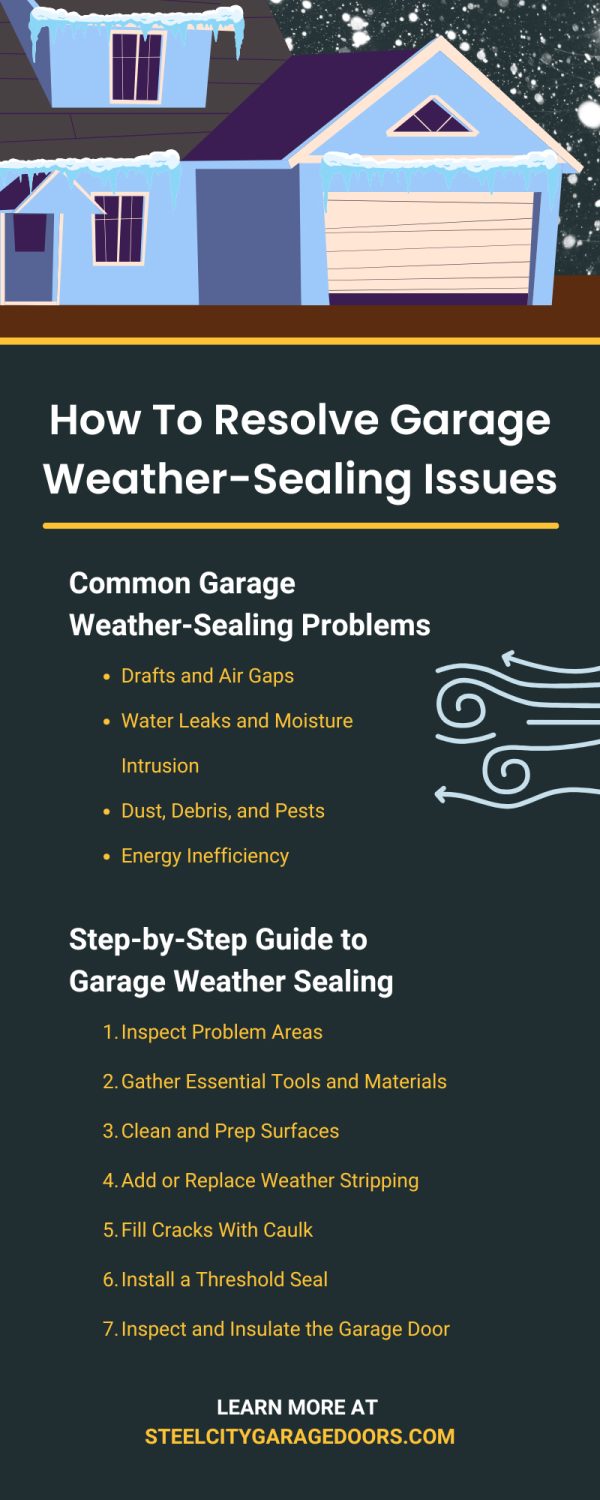A garage should be more than just a space for cars and tools; it should be a protected extension of your home. But when drafts creep through cracks, water pools inside during a storm, or pests find their way through gaps, your garage becomes less of a reliable space. These common weather-sealing issues can cause damage to your belongings, increase energy bills, and invite unwanted guests.
Resolving these issues isn’t just about comfort. It’s about committing to a secure, durable, and energy-efficient solution. Give yourself the knowledge you need to resolve garage weather-sealing issues and create a weatherproof shield for your space.
Common Garage Weather-Sealing Problems
Drafts and Air Gaps
Those small cracks around your garage door might seem insignificant, but they’re responsible for major energy losses. Cold winters or hot summers can push air into your garage and impact the ambient temperature of your home.
Water Leaks and Moisture Intrusion
A poorly sealed garage door becomes a pathway for rainwater, especially during storms. Over time, this issue can lead to moisture damage, mold, and even structural problems. Proper sealing can save you from costly repairs down the line.
Dust, Debris, and Pests
No one wants to hear the scurrying of pests in their garage. Gaps in seals provide easy access for rodents, insects, and windblown debris to get in.
Energy Inefficiency
Unsealed garages can result in fluctuating temperatures that put a strain on your HVAC system. This inefficiency increases heating and cooling bills, which is a concern for any household on a budget.
At Steel City Garage Doors, we can address these issues in businesses and homes. Our expert guidance proves invaluable when considering a garage door repair service in Pittsburgh.
Step-by-Step Guide to Garage Weather Sealing
With sturdy materials and proper application, your garage will stand up to the challenges of every season. Here’s how to seal your space.
Inspect Problem Areas
Begin by examining the garage in detail. Look for gaps around the door edges, cracks in the cement floor, or weak seals along the walls. Perform this inspection on a windy or rainy day to identify water leaks or drafts as they happen.
Gather Essential Tools and Materials
To tackle weather sealing, you’ll need a few necessary tools. Gather materials such as weather stripping, a high-quality caulking gun, threshold seal kits, utility knives, and strong adhesive tape. Measure your spaces carefully so the materials fit properly. Investing in durable, long-lasting materials promises your work will be effective over time.
Clean and Prep Surfaces
Before sealing, all surfaces should be clean and dry. Remove old materials, grease, dust, and debris. This preparation helps new seals adhere properly and remain in place.
Add or Replace Weather Stripping
Weather stripping is one of the most important tools in garage sealing. Measure the edges of your garage door accurately, then cut and adhere the new strips. Weather strips should fit snugly but without obstructing the garage door.
Fill Cracks With Caulk
Use a durable, water-resistant caulk to seal cracks in walls, joints, and floors. Apply the caulk evenly, allowing it to dry fully before testing the seal. Silicone-based caulks tend to perform well in cold or wet environments.
Install a Threshold Seal
A threshold seal adds another layer of defense against water, dust, and pests. These seals work especially well at preventing rain from entering during storms. Choose between self-adhesive seals or those you can secure with screws for extra durability.
Inspect and Insulate the Garage Door
Consider adding insulation to your garage door, especially if it’s thin or outdated. This step improves weather sealing and creates a more consistent temperature inside your garage. Finally, test the door’s balance and alignment to check that it shuts tightly.
Preventative Maintenance Practices
Seal maintenance doesn’t end with installation. Regularly inspect the seals to keep them intact. Harsh weather conditions and frequent use can weaken seals over time, so checking every few months can prevent issues from worsening.
Additionally, by keeping the garage clean and dry, you limit the chances of wear and tear to your seals. A dry, organized garage is less likely to introduce problems such as mold or pests. For major fixes or high-end upgrades, consider reaching out to professionals for long-lasting solutions.
Avoiding Common Weather-Sealing Mistakes
Skipping surface preparation is a mistake that can make adhesion weak and reduce the effectiveness of seals. Be meticulous during cleaning, and make sure cracks are free from debris before applying caulk or weather stripping.
Using improper materials is another common issue. Guarantee all the products you buy are for garage environments, especially those exposed to water or temperature fluctuations. Finally, double-check every section of your work to maintain a consistent, airtight weatherproofing layer.
The Benefits of a Properly Sealed Garage
When your garage is well-sealed, rainstorms won’t leave puddles under your vehicle, and chilly drafts will no longer creep into your home. Energy efficiency improves too, as your HVAC system won’t have to work overtime due to temperature leaks.
Most importantly, resolving garage weather-sealing issues will give you peace of mind while you enjoy every inch of your home. Your tools, vehicles, and belongings will stay protected against the elements, offering a secure, seamless space to use for years to come.
Take the First Step Toward a Weatherproof Garage
Protect and invest in a warm, dry home with the right tools and these steps. You’re now ready to achieve an all-weather garage that withstands time and nature. Steel City Garage Doors offers all the guidance and assistance you need for extensive fixes. Whether you have a persistent leak or require a top-tier garage door repair service, you can count on our experienced professionals.
Transform your garage into a tightly sealed space by starting today—one tool, one seal, and one weatherproof garage at a time. Protect your belongings with a durable space that stands up to any weather condition.





